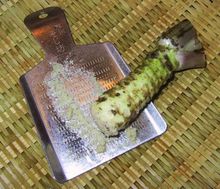Wasabi - A Classic Sushi Accompaniment
What Is Wasabi?

Wasabi is a plant grown primarily in Japan, where it is native, with a small but quickly growing amount now in the Pacific northwest of the US. The root (actually a rhizome) is grated and used in foods to add spiciness and flavor. It is a difficult plant to grow, requiring a rocky stream or riverbed and the proper mix of nutrients, and is therefore a somewhat rare and expensive commodity. While it was traditionally reserved for sushi and noodles, this pungent rhizome is now being incorporated into a large number of foods; however, ‘wasabi’ flavored items are not always really flavored with actual wasabi, but often American horseradish.
Real Wasabi And Fake Cheap Wasabi
When dining and served wasabi with your sushi, the wasabi you are served is not always what it seems. Due to a high demand and limited supply, what is often served with your sushi is a mix of American horseradish, mustard and coloring, which the Japanese call seiyō wasabi (“western wasabi”). This is because real item can be hard to find or very expensive outside Japan (up to $100 per pound).
Wasabi is also sometimes powdered and reconstituted with water, and while this is sometimes served as well, the volatile compounds that make wasabi so unique are lost when the rhizome is powdered, so what you end up is an inferior product (which too is often mixed with American horseradish). If you would like to be sure what you have, you can ask your wait staff if what you are served is ‘real wasabi’ or ‘fresh wasabi’ and if not, if it is available. If you are served putty-like substance, more than likely it is not real.
Real wasabi is grated (traditionally on a sharkskin grater called an oroshi) and looks as such. Fake wasabi is not and does not. Just ask your wait staff for ‘fresh wasabi’ and if they have the real thing, they will usually return with a dish with a grated pile of the real thing, which is a very different experience from fake wasabi. If you are buying the root in a store, read the label to determine if it is the real thing or something a manufactured and processed product that is mostly just horseradish.
The real deal has a fruity and vegetal fragrance, with a spiciness that does not linger and serves to enhance the flavor of the fish. It has a bouquet and sweetness that stimulates the palate with balanced heat. It does not hit with the intensity that fake wasabi does, and the spiciness quickly dissipates into the sweet vegetal flavor that is a perfect companion to sushi. The heat and spiciness is experienced more in the nose or sinus than the tongue and is often an acquired taste.
Traditionally, the itamae (sushi chef) will put the proper amount on nigiri sushi that he deems proper for that particular fish. More for more oily fish, and not as much for the less oily fish. Tradition states that one never put wasabi directly into one’s dish of shoyu (all of this is covered in more detail in our “sushi etiquette” section), however these days, feel free to do what you want, there really are no rules when it comes to one’s dining preferences. I put it on everything and even eat it by itself for fun and to impress others; it is quite an experience!
Wasabi has shown in studies to be anti-microbial and possibly anti-carcinogenic, the former may be why it has long been eaten with raw fish, which in the past was not handled with the care it is today. It is also suggested that it may have anti-inflammatory and blood thinning properties, both useful to the medical community. It is even used in toothpaste in Japan for its anti-bacterial properties!
As you can plainly see, wasabi is a unique plant and more intriguing food. While a mystery to many, this sushi side item is actually very important to many sushi connoisseurs. If you have the opportunity to try the real thing you should be pleasantly surprised. This rare commodity is a spicy treat that is finally being given the praise it deserves as it spreads throughout the food community.
I have always been fascinated by the creation and culture of different foods, particularly sushi and sashimi in the modern era of Japanese cuisine. I am a classically trained chef and sushi connoisseur, also having operated a food service company and enjoy investigating and experimenting with food around the world.